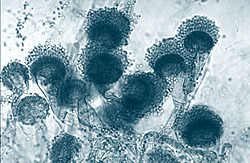
Edition 9 - June, 2001
 Edition 9 - June, 2001 |
Aspergillus fumigatus EBGA subcollection |
Aspergillus fumigatus, which is ubiquitous in the environment, is the most
dangerous fungal pathogen for immunocompromized patients. This is why this species
is being studied so widely at present. From May 1 1997 to June 30 2000, the
BCCM/IHEM Collection was involved in an EU concerted action (Biomed 2 program,
Contract No. BMH4-972481). The acronym was EBGA Network: the European Group
for Research on Biotypes and Genotypes of Aspergillus. Eight teams from five
European countries, France, Belgium, United Kingdom, The Netherlands, Italy,
and Germany took part in this study.
The main goals of this project were:

|
To achieve these objectives, 703 strains of A. fumigatus from 112 patients and their environment were collected and freeze-dried in the BCCM/IHEM Collection. The strains had been isolated from two main groups of patients: invasive aspergillosis patients and lung-transplant patients colonized by A. fumigatus. All of the patients were very well documented: the physician recorded the clinical, imaging, mycological and treatment data. Various sampling approaches were used: multiple isolates from the same clinical sample, sequential isolates from the same patient, isolates from different organs in the same patient, and environmental isolates from home or hospital.
Different laboratories from the network were involved in the typing or antifungal
susceptibility testing study. They received freeze dried vials prepared at the
BCCM/IHEM Collection. This procedure guaranteed the quality of the starting
material used to prepare cultures, DNA, and proteic extracts.
During the project, the strains were distributed to the members of the network
for their studies and had the status of a restricted collection. The members
of the EBGA group decided that this subcollection of A. fumigatus and the related
information would be publicly available in the BCCM/IHEM Collection two years
after the end of the project (June 2002).
This subcollection is not the only one available as isolates from cystic fibrosis
patients have also been collected. These collections are a unique source for
in vitro testing of new antifungal molecules and for the study of the biodiversity
of clinical isolates of this fungus.
Françoise Symoens, Eng.
Tel: +32 (0)2 642 56 30
Fax: +32 (0)2 642 55 19
E-mail: francoise.symoens@iph.fgov.be
Home |
Contents Edition 9 - June, 2001 |